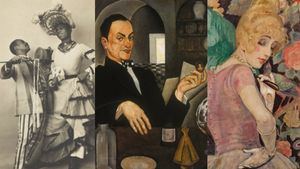A stunning 1st-century villa in Italy has reopened to the public after extensive renovations and a 20-year hiatus.

INSTAGRAM/LUIGI.SPINA.PHOTOGRAPHER
The House of Vettii in Pompeii was originally lost during the eruption of Mt. Vesuvius in 79 C.E. One of the richest and most famous in Pompeii, the villa is also one of the few whose owners are known to modern scholars.
Aulus Vettius Restitutus and Aulus Vettius Conviva Liberti, former slaves who made a fortune trading wine after they were freed, were originally thought to be brothers. However, some researchers now believe the pair were, in fact, gay lovers.

INSTAGRAM/LUIGI.SPINA.PHOTOGRAPHER
The home has all the elements one might expect from wealthy men of the period. It features stunning artwork and opulence not available to commoners of the era.

INSTAGRAM/LUIGI.SPINA.PHOTOGRAPHER
The villa is built around a large peristylium, or open-air central garden filled with plants and water features, as well as statues, frescos, and friezes.

INSTAGRAM/LUIGI.SPINA.PHOTOGRAPHER
While House of Veittii may seem like your average villa owned by the one-percenters of the era, a closer look at one of the statues shows a surprisingly well-endowed figure.

INSTAGRAM/LUIGI.SPINA.PHOTOGRAPHER
The statue in question is that of Priapus, the Roman god of prosperity, and let’s just say he was one well-hung deity.

The villa was under the protection of the packing Priapus and his image appears throughout the villa, such as this fresco painted in a corner space overlooking a pool.

SILVIA VACCA
A closer inspection of the portrait shows Priapus exposing his massive member, complete with support apparatus and an ample foreskin at the tip. No problem docking with this Priapus.

SILVIA VACCA
The artwork in the House of Vettii is not limited to well-endowed gods either. Some art features men and women engaged in more traditional acts of sexual intercourse.
And while many in the past assumed the pair were brothers, Gabriel Zuchtriegel, the director of Pompeii archaeological park, told The Guardianthere’s a far gayer explanation.

INSTAGRAM/LUIGI.SPINA.PHOTOGRAPHER
“If they were from the same family the first two names would have been different and they would have the same surname,” he said. “It was uncommon to have biological siblings who were slaves and then set free, because family ties were cut with slavery so it’s very unlikely they were brothers. It’s more likely that they were buddies during their time as slaves and then set free.”
While there’s no definitive proof the pair of freed slaves were gay lovers, it’s a safe bet to assume Priapus was a top if it came to that.
You can learn more about Pompeii and the House of Vettii at the website www.pompeiisites.org or on Instagram (@pompii_parco_archeologico)































































































